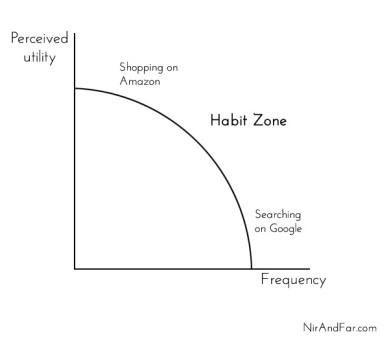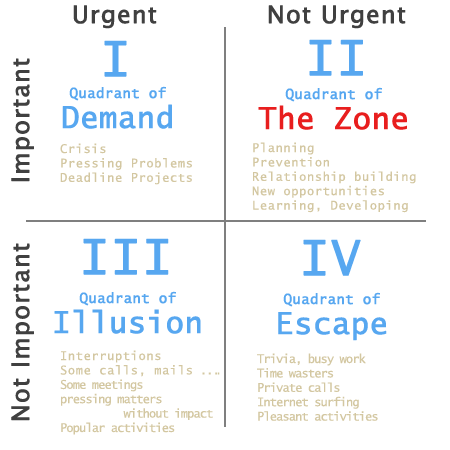Habit, Shmabit & Gamification
We are are going in a direction that will transform us all - I mean all of human beings - in a sort of Pavlov dogs. This is a pessimistic view..
You notice how we can use the diagram to create Habit in humans. Quoting from Nir Eyal, blog Getting Your Product Into the Habit Zone
Not all habits are bad.
We walk dogs, we floss teeth, we smoke, we watch TV, we collect stamps. But the habit formation is used heavily in marketing, and Nir is just the messenger, although a well documented and authoritative one
Now imagine someone in marketing designs habits for us, with the final goal of making us buying, using and paying, directly or indirectly, for services that someone (an only that someone) benefits.
Elevating the sophistication from a dog - I love dogs, here is Charlie - but he doesn't use a computer. ...
The habit in humans, who use a computer, is not to let them leave the site. Amazon offers competitive products ads, and competitive pricing on the same site. Nir gives a spectacular example
Amazon introduced MYHABIT.com a few weeks ago. One can sign with amazon name and password. It is a fashion site, because fashion is something that illustrates Nir's habit diagram best.
The elegant feature of MYHABIT is set in such way, that it imposes no "bad" habits, but just entices them. Sales people can influence the decisions. So a 60% discount (however real this can be) it is already an influence for goodness, not for badness.
Amazon MYHABIT is not George Orwell Animal Farms, is not fascism, communism, used car salesmanship is not even Dr. Pavlov, Nobel Prize 1904. MYHABIT is something to make one feel comfortable s/he does not buy what s/he doesn't like.
My blog covered idea of games, as unpredictable gratification that leads to adiction. But what about pleasurable addictions? Make a game to make chores pleasurable, like dancing when sweeping the floors. Playmatics teamed with Createthe Group to create the Game of Taste.
You decide what habits are good. When in doubt, use Steven Covey's quadrants:
And as educated human beings, we need to double check before making choices. There is a Google out there, a Bing out there and a Twitter.
This blog shows only the beginning of a trend. After these discoveries, GroupOn and FB look more vulnerable, unless they acquire startups to implement the wisdom on a high scale.
You notice how we can use the diagram to create Habit in humans. Quoting from Nir Eyal, blog Getting Your Product Into the Habit Zone
Habits are one of the ways the brain learns complex behaviors. In order to allow us to focus our attention on obtaining new insights, neuroscientists believe habitual behaviors are moved to the basal ganglia, an area of the brain associated with actions requiring little or no cognition. Habits form when the brain takes a shortcut and stops actively deliberating about the decision being made.Nir is (sort of) used with automatic criticism. "With each article I write on the topic of habit formation, I inevitably receive comments about the moral implications of this field."
Not all habits are bad.
We walk dogs, we floss teeth, we smoke, we watch TV, we collect stamps. But the habit formation is used heavily in marketing, and Nir is just the messenger, although a well documented and authoritative one
Now imagine someone in marketing designs habits for us, with the final goal of making us buying, using and paying, directly or indirectly, for services that someone (an only that someone) benefits.
Elevating the sophistication from a dog - I love dogs, here is Charlie - but he doesn't use a computer. ...
The habit in humans, who use a computer, is not to let them leave the site. Amazon offers competitive products ads, and competitive pricing on the same site. Nir gives a spectacular example
... a 2003 study by Trifts and Hubl demonstrates that consumer’s preference for an online retailer increases when they are offered competitive price information. The technique has also been used by Progressive to drive over $15 billion of annual insurance sales, up from just $3.4 billion before the tactic was implemented.Interesting the year of the study is 2003, nearly a decade ago . Never too late, as Nir explains how to create Habits on line.
... Companies can begin to determine their product’s potential for forming a habitual behavior by plotting two factors: frequency (how often the behavior occurs) and perceived utility (how rewarding the behavior is in the eyes of the user). “The Habit Zone,” as I call it, is where an action occurs with enough frequency and perceived utility for it to become the default behavior
 |
| Reproduced from Nir Eyal Blog |
Amazon introduced MYHABIT.com a few weeks ago. One can sign with amazon name and password. It is a fashion site, because fashion is something that illustrates Nir's habit diagram best.
The elegant feature of MYHABIT is set in such way, that it imposes no "bad" habits, but just entices them. Sales people can influence the decisions. So a 60% discount (however real this can be) it is already an influence for goodness, not for badness.
Amazon MYHABIT is not George Orwell Animal Farms, is not fascism, communism, used car salesmanship is not even Dr. Pavlov, Nobel Prize 1904. MYHABIT is something to make one feel comfortable s/he does not buy what s/he doesn't like.
My blog covered idea of games, as unpredictable gratification that leads to adiction. But what about pleasurable addictions? Make a game to make chores pleasurable, like dancing when sweeping the floors. Playmatics teamed with Createthe Group to create the Game of Taste.
“Taste is a game. You play it everyday. But it’s not about building a game, it’s about doing what games do. It’s the applied use of elements found in gaming for nongaming consumer products, services and applications.”Shuffle Brain , a husband and wife team will design custom games
We’re passionate about creating games that keep you sharp and socially connected, and inspired by new opportunities to apply game design thinking to business, education and healthBunchball is most direct as they define themselves as the leaders in the gamification of the customer to replace this legacy marketing:
Traditional models of marketing to your customers are dead. Most customers now ignore targeted marketing campaigns, avoid responding to offers, and provide minimal feedback when asked. Instead, potential customers are now interacting with each other, leveraging consumer-focused social platforms to bypass sanitized corporate messages devoid of meaning or value.Kiip follows your mobile apps and offers each user rewards, prizes, instant gratifications. This is what FB does now with great fanfare.
You decide what habits are good. When in doubt, use Steven Covey's quadrants:
 |
| The 7 Habits of Highly Successful People |
And as educated human beings, we need to double check before making choices. There is a Google out there, a Bing out there and a Twitter.
This blog shows only the beginning of a trend. After these discoveries, GroupOn and FB look more vulnerable, unless they acquire startups to implement the wisdom on a high scale.





Comments